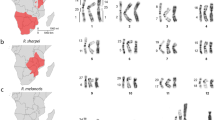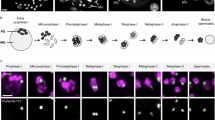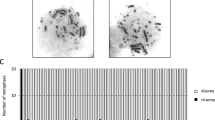Abstract
ALTHOUGH the chromosomes of thousands of plants and animals have been investigated and chromosome numbers found to vary widely, the overall trend has been toward the evolution of a moderate number in most taxa. Very few species have been reported to have as few as n = 2 chromosomes. Jackson1 reported the flowering plant Haplopappus gracilis to be n = 2 and most cytology textbooks indicate that the nematode Parascaris equorum (= Ascaris megalocephala) possesses one pair of chromosomes in germ line cells. In the latter species, however, the two chromosomes fragment into numerous small chromosomes in the soma, and therefore the germ line chromosomes are considered aggregate bodies2. In the Insecta some coccid members of the tribe Iceryini have a haploid number of two chromosomes and unfertilized haploid eggs develop parthenogenically into males3. Sokolov4 found two species of water mites (Eylais rimosa and Eylais setosa) to be n = 2, but these species do not display haploid parthenogenesis. The rarity of reported cases of such a low chromosome number throughout the plant and animal kingdoms prompted us to report the following data.
This is a preview of subscription content, access via your institution
Access options
Subscribe to this journal
Receive 51 print issues and online access
$199.00 per year
only $3.90 per issue
Buy this article
- Purchase on SpringerLink
- Instant access to full article PDF
Prices may be subject to local taxes which are calculated during checkout
Similar content being viewed by others
References
Jackson, R. C., Science, 126, 1115 (1957).
Swanson, C. P., Cytology and Cytogenetics, 596 (Prentice-Hall, Inc., Englewood Cliffs, New Jersey, 1957).
Hughes-Schrader, S., Adv. Genetics, 2, 127 (1948).
Sokolov, I. I., Trud. Leningrad. Obshch. Estestvois., Otd. Zool., 72, 124 (in Russian, 1954).
Brown, S. W., and Bennett, F. D., Genetics, 42, 510 (1957).
Author information
Authors and Affiliations
Rights and permissions
About this article
Cite this article
OLIVER, J., NELSON, B. Mite Chromosomes : an Exceptionally Small Number. Nature 214, 809 (1967). https://doi.org/10.1038/214809a0
Received:
Issue date:
DOI: https://doi.org/10.1038/214809a0
This article is cited by
-
The first karyotype study in palpigrades, a primitive order of arachnids (Arachnida: Palpigradi)
Genetica (2008)
-
Cytological and radioassay evidence of haploid parthenogenesis inCheyletus malaccensis (Acarina:Cheyletidae)
Genetica (1974)
-
Minimal chromosome number in false spider mites (Tenuipalpidae)
Experientia (1972)
-
A study on sex-determination and karyotypic evolution inTetranychidae
Genetica (1970)



